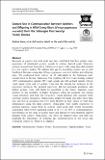Files in this item
Gesture use in communication between mothers and offspring in wild orang-utans (Pongo pygmaeus wurmbii) from the Sabangau peat-swamp forest, Borneo
Item metadata
| dc.contributor.author | Knox, Andrea | |
| dc.contributor.author | Markx, Joey | |
| dc.contributor.author | How, Emma | |
| dc.contributor.author | Azis, Abdul | |
| dc.contributor.author | Hobaiter, Catherine | |
| dc.contributor.author | van Veen, Frank J.F. | |
| dc.contributor.author | Morrogh-Bernard, Helen | |
| dc.date.accessioned | 2019-07-08T15:30:02Z | |
| dc.date.available | 2019-07-08T15:30:02Z | |
| dc.date.issued | 2019-06 | |
| dc.identifier | 259064315 | |
| dc.identifier | 2b69b20a-3cf9-407f-82b3-8d1cb1e5087f | |
| dc.identifier | 85068106816 | |
| dc.identifier | 000481758200007 | |
| dc.identifier.citation | Knox , A , Markx , J , How , E , Azis , A , Hobaiter , C , van Veen , F J F & Morrogh-Bernard , H 2019 , ' Gesture use in communication between mothers and offspring in wild orang-utans ( Pongo pygmaeus wurmbii) from the Sabangau peat-swamp forest, Borneo ' , International Journal of Primatology , vol. 40 , pp. 393–416 . https://doi.org/10.1007/s10764-019-00095-w | en |
| dc.identifier.issn | 0164-0291 | |
| dc.identifier.other | ORCID: /0000-0002-3893-0524/work/59464851 | |
| dc.identifier.uri | https://hdl.handle.net/10023/18054 | |
| dc.description | Funding: US Fish and Wildlife Service Great Apes Conservation Fund, ARCUS, The Kronendak Foundation, and the Borneo Nature Foundation (BNF). | en |
| dc.description.abstract | Research on captive and wild great apes has established that they employ large repertoires of intentional gestural signals to achieve desired goals. However, gestural research has focused on African great apes, with orang-utan data limited to a few captive studies. We address this gap by describing gesture use in wild Southwest Bornean orang-utan (Pongo pygmaeus wurmbii) mother and offspring pairs. We conducted focal follows on 16 individuals in the Sabangau peat-swamp forest in Borneo, Indonesia. The resulting 681 hours of video footage yielded 1,299 communicative signals: 858 vocal signals and 441 gestural signals. Eleven vocal signal types and twenty-one gesture types met the criterion for inclusion in the repertoire; however, the repertoire did not approach asymptote and further gesture types will likely be identified in the future. Signallers used gestures of any modality in higher frequency when the recipient was paying visual attention, and took the recipient’s visual attention into account when selecting gesture modalities. Orang-utans employed hands and arms more than legs and feet in gesturing, but were more flexible in their choice of limb than chimpanzees using the same gestures. Orang-utans were highly responsive to gestural requests, using them to achieve eight goals and, where successful, responding either before gesturing ended or in under 1-second in 90% of communications. Our findings on the range of gesture types and impact of visual attention support findings from captive orang-utans; and those on responsiveness and limb-use highlight the importance of studying ape communication in the social and ecological context to which it is adapted. | |
| dc.format.extent | 24 | |
| dc.format.extent | 516312 | |
| dc.language.iso | eng | |
| dc.relation.ispartof | International Journal of Primatology | en |
| dc.subject | Pongo | en |
| dc.subject | Gesture | en |
| dc.subject | Vocal | en |
| dc.subject | Signal modality | en |
| dc.subject | Attention state | en |
| dc.subject | Responsiveness | en |
| dc.subject | BF Psychology | en |
| dc.subject | NDAS | en |
| dc.subject.lcc | BF | en |
| dc.title | Gesture use in communication between mothers and offspring in wild orang-utans (Pongo pygmaeus wurmbii) from the Sabangau peat-swamp forest, Borneo | en |
| dc.type | Journal article | en |
| dc.contributor.institution | University of St Andrews. Centre for Social Learning & Cognitive Evolution | en |
| dc.contributor.institution | University of St Andrews. School of Psychology and Neuroscience | en |
| dc.identifier.doi | 10.1007/s10764-019-00095-w | |
| dc.description.status | Peer reviewed | en |
| dc.date.embargoedUntil | 2019-06-24 |
This item appears in the following Collection(s)
Items in the St Andrews Research Repository are protected by copyright, with all rights reserved, unless otherwise indicated.

